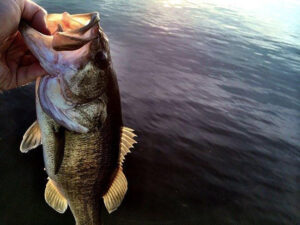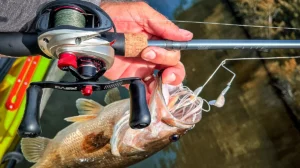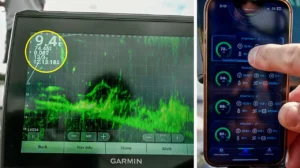Every angler has a specific technique that really boosts their confidence. While some reach for jigs, soft plastics or even topwater lures when searching for big bites, I’m a huge proponent of cranking shallow cover for bass. Instead of the more traditional retrieve methods, however, I like to “high-stick” my crankbait whenever possible.
After several years of teaching this technique to countless guide clients, I’ve put together some simple tips to help you avoid the common mistakes and unleash an extremely powerful weapon in your cranking arsenal.
- Understand the advantages
- Target high-percentage areas
- Experiment with your retrieve speed
- Bite detection and hooksets are very important
What is high-sticking and why does it work?
High-sticking your crankbait involves using 4 to 6-foot diving squarebills to target very shallow water and keeping your rod tip at the 12 o’clock position throughout the entirety of the retrieve. Essentially, you’re doing the exact opposite of what you’ve likely been taught to do when fishing with crankbaits.
There a few important things to understand before we delve into the more technique-specific aspects.
- There’s a time and place for it—I’m not suggesting that you throw your crankbait mechanics out of the proverbial window. They remain important and there are many times when they apply. This technique just allows you to target very shallow depths with a bigger profile lure.
- It will feel awkward—Trust me. I’ve been doing this for years and it still feels a little strange. As I mentioned, most of us are hardwired to keep our rod tips down and to-the-side when cranking, so you can expect a learning curve. It’s not uncommon to miss your first few bites when learning this technique, so don’t get frustrated. It’s just like riding a bike, though. When you successfully land your first fish, you’ll quickly understand what it’s all about.
- It will look awkward—So much of bass fishing is image-driven these days, but don’t let that get into your head. Your reel will be directly in front of your face and you’re going to look like you’re clueless out there, but who cares? You’ll probably be catching fish.
- Make some room for yourself—I usually don’t mind at all when people stand beside me on my front deck. But high-sticking will result in some fairly goofy, emphatic hooksets every now and then, so it’s a good idea to clear some space and keep a good distance from your fishing partner. After losing several big bass due to the fear of knocking my partner’s head off, I won’t make this mistake again.
Now that we have all of that out of the way, let’s get to the fun part. When I introduce this technique to people, I’m always asked, “Why don’t you just use a wakebait or lipless crankbait and save yourself the trouble?” That’s a valid question and I totally understand the thought process behind it. Here are my reasons.
- Snag resistance—Combining treble hooks and very shallow water is often a recipe for snags and hang-ups. Lipless crankbaits can work in super-shallow water, but their deflection properties are very limited. Wakebaits are a little better in terms of deflection, but they swim on a very horizontal plane. Without the nose diving downward, the treble hooks are largely exposed and apt to catch anything in their path. High-sticking squarebills, however, allows you to cover water efficiently without these irritating snags.
- Wider wobble—I’m no biologist, but I believe a wide, aggressive wobble forces bass to react and quite frankly, it ticks ’em off. Because lipless crankbaits sink, you have to reel them quickly to maintain a proper profile in very shallow water. The quicker you reel these lures, the tighter wobble they have. Conversely, you can achieve a wide wobble from a wakebait when you retrieve it slowly, but the slower you reel, the shallower they dive. This makes it difficult to collide with submerged cover. High-sticking squarebills gives you much more control over the depth and action of your lure.
Don’t be a robot
Everyone reading this article—including the author—is guilty of this sometimes. It’s been a while since we got a bite, so we make a long cast with a squarebill and start daydreaming and lose concentration. It seems like the fish catch onto this, because that’s when a lot of bites happen. I refer to it as “getting caught with your pants down”.
Whatever you do, make a concerted effort to avoid this. Your high-sticking success is largely dependent upon dialing into the most effective retrieve at any given time. You’ll catch a few with a steady retrieve, but there are three others you should try.
- Stop-and-go—This is probably my most consistent producer when I’m high-sticking crankbaits. I’ll make a long cast, bring my reel directly in front of my nose with the rod tip straight-up in the air and slowly reel three or four times and before letting the crankbait rise a few inches. Not only does this keep the lure in the strike zone longer, but it also keeps it from digging into nearby weeds, pine straw and muck too much.
- Pull-and-rip—When you’re around aggressive fish, this is an excellent way to make ’em eat. Again, make a long cast, but this time you want to move your crankbait with your rod instead of your reel. Pull it towards you a few inches and give your rod tip a quick, upward “rip”. If a big bass is down there lazily watching your crankbait and she suddenly thinks it’s getting away, she’s likely to attack it. In other words, this retrieve preys on their instinctual weaknesses.
- Float-and-reel—Like I’m sure many of you did, I used this retrieve with small Rapala crankbaits in farm ponds as a child. In lowlight hours especially, I’ll make a cast and let the crankbait just sit on the surface for two to three seconds. Still keeping my rod positioned at 12 o’clock, I’ll turn my reel handle a few times before pausing my retrieve and letting the crankbait return to the surface. I’ll let it sit motionless again and repeat the process. This will produce some awesome topwater strikes.
Bite detection
Whenever you’re cranking the “conventional” way, bites are usually very easy to detect—your rod will load up, your reel handle will stop or your crankbait will start to feel very “mushy”. That’s not necessarily the case when high-sticking, however.
There are three things to look for when detecting bites with this method.
- Slack line—Much like worm or jig fishing, keep a close eye on your line throughout your entire retrieve. When you see it jump, twitch or fall slack on top of the water, you most likely have a bite.
- Wait for the thump—A lot of your high-sticking bites will feel identical to a jig bite. It doesn’t matter if your crankbait is paused or on-the-move—it’s impossible to mistake it. You’ll feel a big “thump” on the end of your line and in my experience, it’s usually a big one when this happens.
- Added weight—After a few hours of trial-and-error, you’ll start to get a solid feel for the “weight” of your lure on the end of your line. You’ll know what it’s supposed to feel like and when you feel any added weight, before setting the hook, hold your line tight and look at your line. If there’s any movement to it, it’s time to set the hook.
Obtain leverage for your hookset
The hookset is the interesting and—if you don’t take yourself too seriously—funny part of this whole high-sticking deal. Again, you will miss some fish. It’s just the nature of it. But I’ll take you through my hookset process to help shorten your learning curve.
Whenever you feel a bite, try to resist the urge to pull straight back. Because of your 12 o’clock rod position, you don’t have much leverage. And by pulling upward, you are forcing the top of the crankbait—the part with no hooks—into the hard, bony part of the bass’ mouth. Instead, your goal is to keep a tight line on the fish while getting into the proper position for a sweeping hookset. Essentially, you need to buy a little time before laying the wood to ’em.
First, you need to slightly—don’t go crazy with it—increase your retrieve speed to ensure no slack enters your line at any time. While reeling, drop your rod tip to the 4 o’clock position and point your rod tip at the fish—remember, keep reeling. This new rod position gives you much more leverage throughout both the hookset and the fight. It’s important.
When your rod reaches the 4 o’clock position, pull your rod tip to the side. Again, you don’t want any slack in this entire process, so try not to snatch. Just a solid pull will ensure suitable hook penetration and will put you in great position to counter any runs or jumps the bass may attempt.
The next time you’re fishing super shallow water, think outside of the box and try your hand at high-sticking squarebill crankbaits. It’s a great way to trick otherwise lethargic bass and find a special pattern than other anglers may be totally overlooking.














